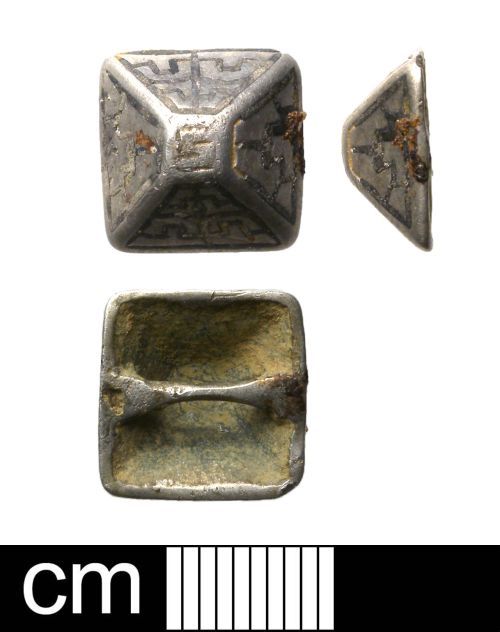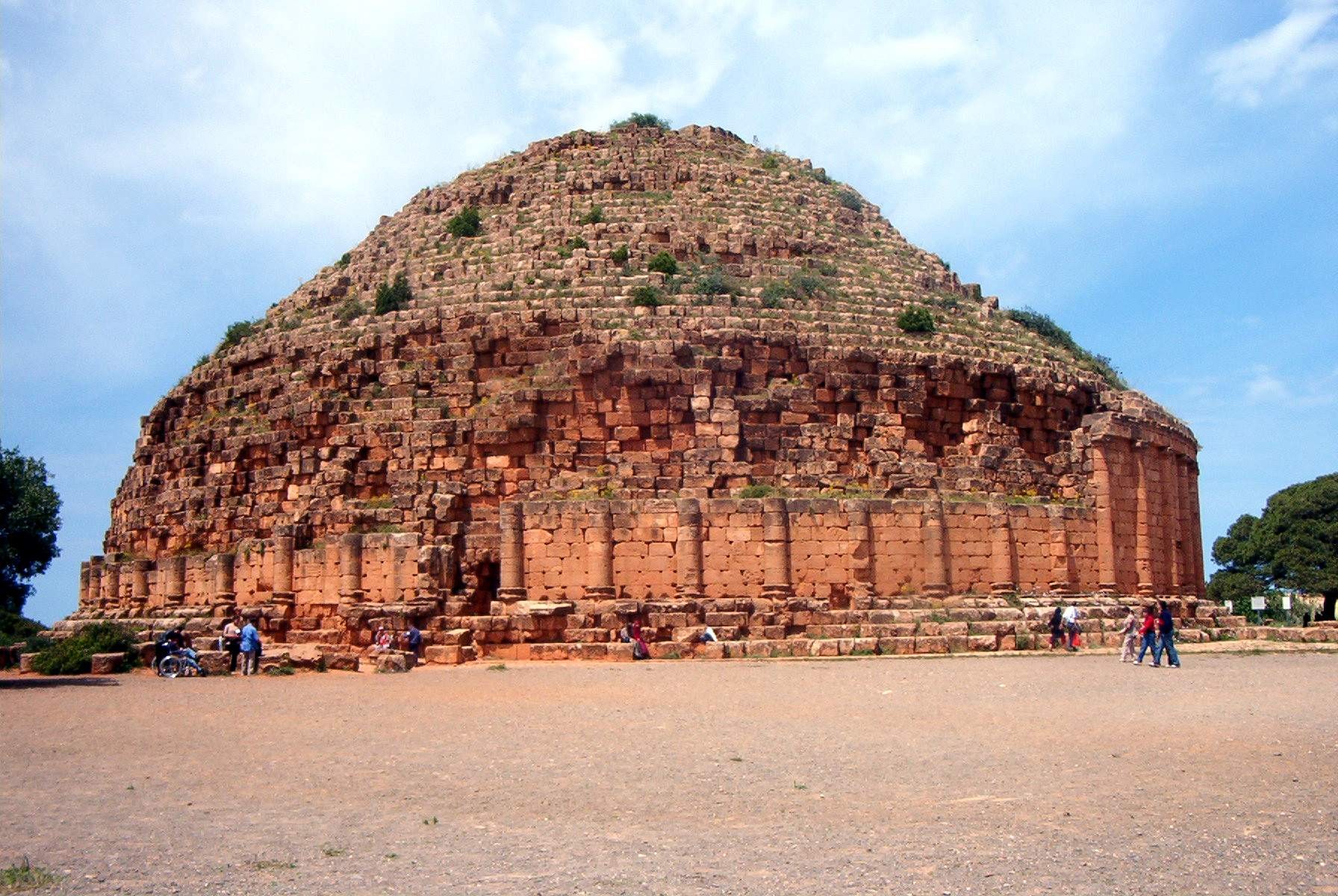Total posts:
187
08/02/2013

Anglo-Saxon silver scabbard mount
Earlier this year, Dr Stephen Hammond discovered an Anglo-Saxon silver pyramid-shaped sword scabbard mount in Heacham, Norfolk.
He recorded the find with the Norfolk Identification and Recording Service, (who host the Portable Antiquities Scheme’s Finds Liaison Officer) who reported the mount to the coroner as potential Treasure.
Early Medieval sword scabbard mount are fascinating and wonderfully designed objects. There are several gold and garnet examples in the Staffordshire Hoard and the Sutton Hoo burial, and it is thought that scabbard mounts like may have served a practical purpose in helping to secure the sword in its scabbard by means of a straps running through the loop on the back. The mount found by Dr Hammond features intricate geometric designs in niello, a shiny black metallic compound used for decorative effect.
In an act of great generosity, Dr Hammond and the owner of the land both agreed to forego any reward in order that the sword scabbard mount could be acquired by Norwich Castle Museum at no expense. In the course of doing so, Dr Hammond was reminded of the first time he had made a donation to Norwich Castle Museum, in 1952! Amazingly, he still had the certificate issued by the Town Clerk acknowledging his deed of 60 years ago.
Dr Hammond has had more than a handful of Treasure finds over the years, but this historic document shows just how long he has been pursuing his hobby. Thank you again Dr Hammond, to you and the landowner!
07/31/2013
I’m currently working on mapping PAS data to the CIDOC-CRM and I’m trying to align our thesauri with the SENESCHAL uris. To get the all the URIs from their system, run this SPARQL query on their endpoint with the URI, preferred label and scope note being obtained. I can then dump these into my database or create a CSV file easily from the results to reference later.
FISH object thesaurus
To obtain the URIs and extra information from the FISH archaeological objects thesaurus which number 2020:
PREFIX skos: <http://www.w3.org/2004/02/skos/core#>
SELECT *
WHERE {
?subject a skos:Concept ;
skos:inScheme <http://purl.org/heritagedata/schemes/mda_obj> ;
skos:prefLabel ?label ;
skos:scopeNote ?note
}
ORDER BY ASC(?label)
EH periods
To obtain the English Heritage period URIs which number 30 in total:
PREFIX skos: <http://www.w3.org/2004/02/skos/core#>
SELECT *
WHERE {
?subject a skos:Concept ;
skos:inScheme <http://purl.org/heritagedata/schemes/eh_period>;
skos:prefLabel ?label;
}
ORDER BY ASC(?label)
EH Building materials
To obtain the English Heritage building materials URIs which number 231 in total:
PREFIX skos: <http://www.w3.org/2004/02/skos/core#>
SELECT *
WHERE {
?subject a skos:Concept ;
skos:inScheme <http://purl.org/heritagedata/schemes/eh_tbm>;
skos:prefLabel ?label;
}
ORDER BY ASC(?label)
EH Event types
To obtain the English Heritage event type URIs of which there are 97:
PREFIX skos: <http://www.w3.org/2004/02/skos/core#>
SELECT *
WHERE {
?subject a skos:Concept ;
skos:inScheme <http://purl.org/heritagedata/schemes/agl_et> ;
skos:prefLabel ?label ;
}
ORDER BY ASC(?label)
EH monument types
To obtain the EH monument type URIs of which there are 4855:
PREFIX skos: <http://www.w3.org/2004/02/skos/core#>
SELECT *
WHERE {
?subject a skos:Concept ;
skos:inScheme <http://purl.org/heritagedata/schemes/eh\_tmt2> ;
skos:prefLabel ?label ;
}
ORDER BY ASC(?label)
Counting results
To get a count for any of these:
PREFIX skos: <http://www.w3.org/2004/02/skos/core#>
SELECT (COUNT(*) AS ?count)
WHERE {
?subject a skos:Concept ;
skos:inScheme <SCHEME URI> ; }
Offsetting
The end point returns a maximum of 250 records, and so to get more results, use OFFSET n as shown below:
PREFIX skos:
SELECT *
WHERE {
?subject a skos:Concept;
skos:inScheme <YOUR SCHEME URI>;
skos:prefLabel ?label;
skos:scopeNote ?note
}
ORDER BY ASC(?label)
OFFSET 250
07/29/2013
A couple of weeks ago, the project was lucky to have Dr Beth Greene, an expert in Roman shoes, from the University of Western Ontario, take a look at our small assemblage of leather from the river. She’s worked extensively on the Roman shoes from Vindolanda (http://www.vindolanda.com/doorway-articles/life-at-vindolanda), so she’s well placed to study our footwear! Here’s what she has to say about them:
Our Roman shoe expert, Beth Greene
“At the moment, only three Roman leather shoes have been recovered from the river deposit for study. However, Bob and Rolfe have re-buried dozens more, so there’s massive potential for further work which could keep me busy for some time!
So, here’s the good news: the shoes are most definitely Roman! They are all very well preserved and tell us a great deal about their previous owners and perhaps also the individual who deposited them in this watery resting place. One is a small sandal of about 22cm long (before chemical conservation) that may have belonged to a woman or an adolescent male. The sandal is an interesting shape that developed at the end of the 2nd century and into the 3rd, with a flat toe area and very wide at the toes and ball of the foot. This sandal type evolves to become enormous at the toe end and eventually looks more like a ping-pong paddle than a shoe! Our example is more sensible in its stylistic details, but still has a flare that can only be chalked up to fashionable tastes rather than practicality.
A leather shoe, with fashionable paddle-shaped foot.
Another shoe also follows the trends of the time with a very pointed toe. There are at least 6-10 cm. at the end of this insole that would never have been properly walked in, but exist in order to create a certain style for the shoe with a very elongated and pointed toe. This style became popular toward the end of the 2nd century. I often think these look a lot like modern ‘winklepickers’, a shoe style inspired by medieval French nobles and popular since the 1950s with rock and rollers, mods, goths, and punks—generally the footwear choice of many culturally alternative groups. I don’t think this is what the Romans had in mind. It was just a fashion trend as far as I surmise, but it just goes to show that the Romans were once again the innovators!
With luck there will be more shoes to look at it to provide some statistically significant data. It’s early days right now and possibly pure coincidence, but one interesting detail is that all three shoes are left-footed, the inauspicious and evil side as far as the Romans were concerned (the Latin word for left is ‘sinistra’, where we get the English word ‘sinister’). If I were giving away one shoe to the deity, I’d surely pick the one that brings bad luck!
07/25/2013
The Friends of Ludlow Museum are today launching a fund to acquire and conserve the Bitterley Hoard.
This hoard was discovered in 2011 by Howard Murphy, a local metal detecting enthusiast in the Bitterley Area, South Shropshire. On discovering the hoard, Mr Murphy did exactly the right thing and left it in the ground. He contacted the PAS locally in Shropshire and the hoard was archaeologically excavated and recorded. The hoard was lifted in a single block of soil and transferred to the British Museum where conservation staff excavated the coins.
Once excavated the British Museum found that the hoard comprised 137 silver and a single gold coin that had been placed within a very fragile leather purse (PAS Treasure Report). The purse, in turn, had been placed within a pottery drinking cup called a tyg. The purse is a rare survival as most organic artefacts rot within the soil – this has been preserved by being protected by the tyg which had its own waterlogged (anaerobic) environment.
The hoard was declared treasure in June 2012 and has since been independent valued. Shropshire Museums are keen to acquire and display the hoard at Ludlow Museum. They have already received promises of support from the V&A Purchase Fund and the Headley Trust. Shropshire Museums alongside the Friends of Ludlow Museum, are attempting to raise the last monies locally to acquire the hoard and pay for the conservation costs of the tyg and most importantly the leather purse. For more information on how you can help with this bid please visit the Facebook page of Ludlow Museum
Peter Reavill
July 2013
For more information about the hoard and its discovery visit my Day Of Archaeology Blog 2012
07/16/2013

A bronze coin of Juba II of Numidia
There are nearly 1,300 coins amongst the assemblage of finds from Piercebridge. Most represent types which were circulating
in Britain in the Roman period. However, there are a couple of more unusual coins, which perhaps you wouldn’t expect to
turn up in County Durham. Amongst these is a bronze issue of Juba II . Juba II reigned as client-king of Rome over Numidia
and Mauretania (an area which covers modern Algeria, Morocco and Tunisia) in the late 1st century BC. He had spent his
childhood in Rome, as a ‘hostage’ and had been raised by Julius Caesar and later Augustus. He even married the daughter
of Cleopatra and Mark Antony, Cleopatra Selene II.
It is not clear how one of his coins arrived in Piercebridge, although ‘exotic’ coins like this one, do occasionally turn up in large assemblages, particularly those from temple sites. Perhaps it arrived in the pocket of a traveller, soldier or merchant who had visited or lived in North Africa and thought it an appropriate personal offering for the Gods…

The tomb of Juba II in Tipaza, Algeria (Wikipedia)
07/12/2013
In July 2010, James Balme discovered a small hoard of eight Roman denarii in Warburton, Cheshire. The hoard was declared Treasure and acquired by Manchester Museum. In the meantime, James had discovered a further denarius on the same location, LVPL-131DE4 . Since the new coin had clearly been a member of the original hoard, it was declared to be an addenda to the first case, and was found to be Treasure as well.

In order to ensure that the new discovery would follow the first eight coins to Manchester Museum, James and the owner of the land waived their right to a reward. We’re very grateful for their gesture, and its good to see what really motivates James – here’s what he had to say on Twitter:
PS – Thanks James for ignoring the typo on your certificate!


